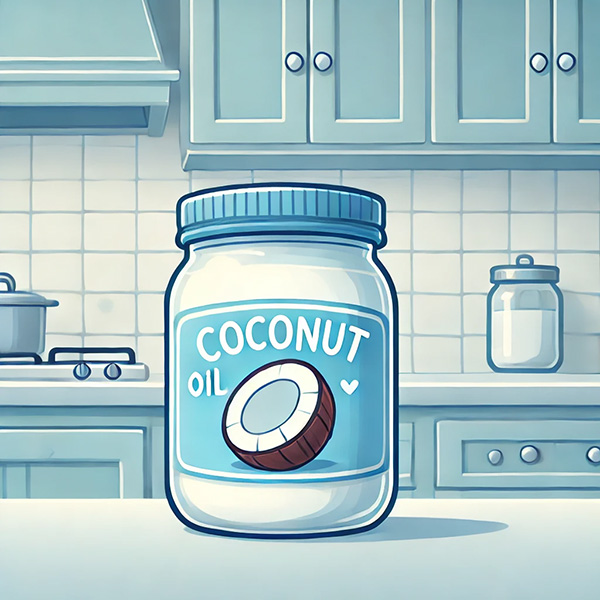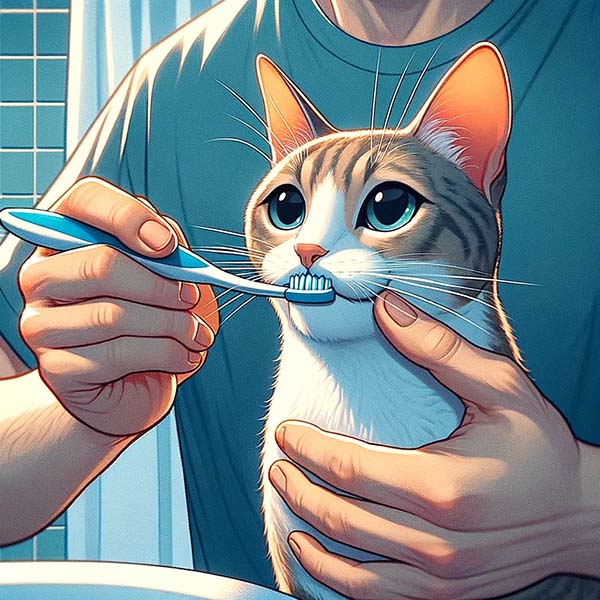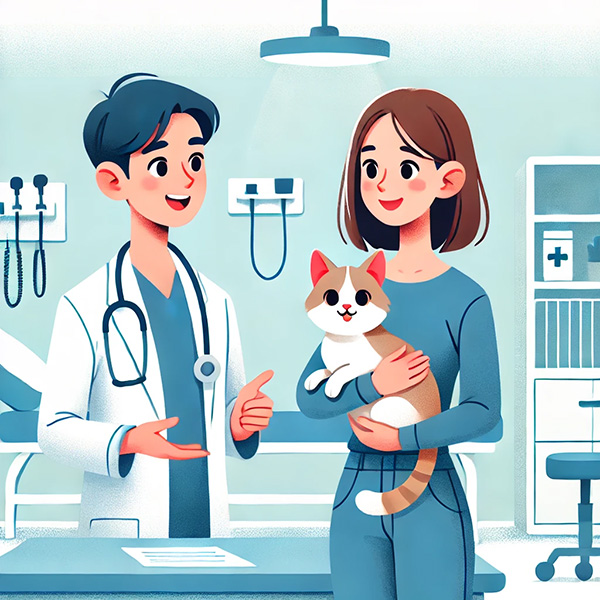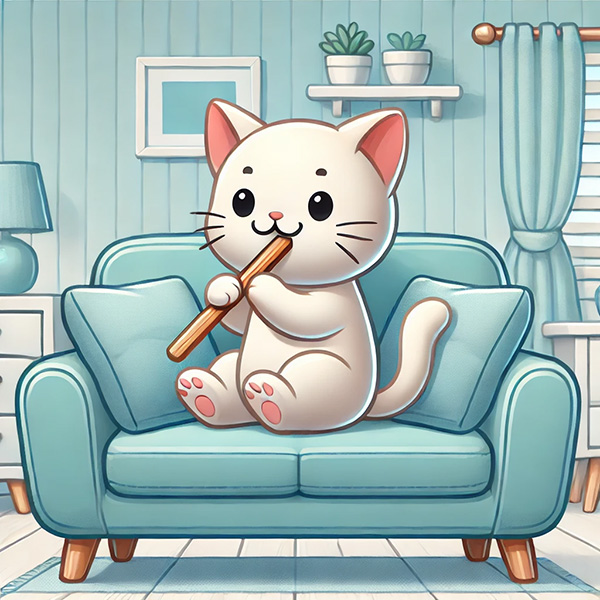Keeping your cat's dental health in good shape is essential for their overall well-being, but using cat toothpaste can be tricky at times. Many cats dislike the flavors or textures of commercial cat toothpaste, but there's good news—brushing your cat’s teeth without toothpaste is possible and can be effective. Natural alternatives such as coconut oil, baking soda, or even just a damp toothbrush can be used to clean your cat’s teeth safely and effectively. These options gently remove plaque and freshen their breath, ensuring your feline friend maintains optimal oral health without the stress and fuss of traditional toothpaste. Avoid using human toothpaste, as it may contain fluoride and xylitol, both of which are highly toxic to pets. Instead, choose straightforward and safe alternatives to maintain your cat's dental health.
how to brush your cats' teeth clean without toothpaste
Choosing the Right Tools

Choosing the right tool for brushing your cat's teeth without traditional toothpaste is crucial for ensuring the process is both effective and comfortable for your pet. Cat-specific toothbrushes are designed with soft bristles and smaller heads tailored to fit comfortably in a cat’s mouth, making them ideal for gentle cleaning. Silicone finger brushes are another excellent option; they slip over your finger, giving you better control and sensitivity while brushing, which can be less intimidating for your cat.
Introducing these tools should be done gradually. Allow your cat to first become familiar with the toothbrush or finger brush without any brushing action. This can involve letting them sniff and lick the brush during calm moments, slowly building their comfort level.
Select Natural Cleaning Agents

When selecting natural cleaning agents for brushing your cat's teeth, choosing safe and effective ones is important. Here are three natural alternatives:
Coconut Oil
Coconut oil, renowned for its antimicrobial properties, is a safe and natural option for cleaning your cat's teeth. It aids in combating oral bacteria, which can lead to plaque buildup and gum disease. To use coconut oil, apply a small amount on a cat-specific toothbrush or a silicone finger brush and gently brush the teeth. Many cats also enjoy the taste of coconut oil, which can make the brushing experience more pleasant for them.
Baking Soda Paste
Baking soda is another effective natural cleaner used to clean your cat's teeth. Combine a small amount of baking soda with water to make a paste. Use this mixture sparingly and gently brush the teeth, as baking soda is abrasive and can irritate your cat's gums if used excessively. Its mild abrasive nature helps remove plaque and polish teeth effectively, but it should be used cautiously to avoid any harm.
Parsley Water
Parsley is valued for its antibacterial properties and can serve as a natural mouth rinse for cats. To prepare parsley water, steep fresh parsley leaves in boiling water, let it cool, strain the leaves, and use the resulting liquid to rinse your cat's mouth gently. This can freshen breath and decrease bacteria without requiring brushing. It's a gentle approach that is especially useful for cats who may resist traditional brushing methods.
How To Brush Your Cat's Teeth Without Toothpaste

When brushing your cat's teeth without pet toothpaste, a gentle, step-by-step approach is essential to ensure the experience is positive and stress-free for your pet. Here’s a guide on how to brush your cat's teeth effectively:
Start by Massaging the Gums: Before introducing any tools, use your clean finger to massage your cat’s gums gently. This helps your cat acclimate to the sensation of having something besides food in its mouth. Do this in short, positive sessions, rewarding your cat with praise or a treat to build positive associations.
Introduce the Toothbrush: Once your cat is comfortable with gum massages, introduce a cat toothbrush designed for cats. At first, introduce the brush without using it, allowing your cat to sniff and explore it. Gradually, your cat will start touching the soft bristles of its teeth and gums without making brushing movements. Ensure your cat is comfortable at this stage before moving forward.
Begin Brushing: Begin by gently brushing the outer surfaces of the teeth. Use a soft-bristled brush and make small, circular motions, focusing on the gum line where plaque often builds up. Begin with the front teeth, which are generally easier to access, and as your cat becomes more accepting, you can slowly move to the back teeth.
Increase Coverage Gradually: As your cat becomes more accustomed to brushing, gradually extend the brushing sessions and increase the number of teeth cleaned. Always monitor your cat’s comfort level and stop if you notice any signs of stress or discomfort. Making each session short and positive is important, stopping while your cat is still comfortable.
Regular Sessions: Consistency is key. Try to make brushing a regular part of your routine, aiming for several times a week. This regularity helps your cat maintain dental hygiene and get used to brushing over time.
Use Professional Advice and Regular Check-ups

Seeking professional advice and scheduling regular check-ups with a veterinarian are essential steps in establishing a dental care regimen for your cat. Here’s why and how you should engage professional services:
Consultation Before Starting: Consult with a veterinarian is crucial before you begin any dental regimen, especially if you plan to introduce tools or products like dental wipes or specific brushes. A vet can assess your cat’s overall oral health and identify any underlying issues, such as gingivitis, periodontal disease, or tooth resorption, that may affect how you go about dental care. Some cat breeds are at a higher risk of dental disease. With guidance from a veterinarian, you can receive personalized advice tailored to your cat's individual needs.
Professional Dental Cleanings: While regular brushing at home is important, professional cleanings by a veterinarian are necessary to remove plaque and tartar build-up that can't be brushed away. These cleanings should be performed under anesthesia to allow a thorough examination and cleaning below the gumline, where most dental diseases start.
Regular Check-ups: Regular dental check-ups, recommended at least once a year, help monitor the progression of your cat’s dental health and catch any new issues early. During these check-ups, a veterinarian can also update you on the best practices in dental care specific to your cat’s condition, adjusting the home care routine as necessary.
Continued Guidance: Regular vet visits also allow you to refine your brushing technique or discuss the effectiveness of your dental products. The veterinarian may recommend adjustments or improvements to enhance the effectiveness of your home care routine.
Professional oversight ensures that your cat maintains optimal oral health and that any dental issues are managed promptly and effectively. Regular veterinary input and cleanings are indispensable parts of a holistic approach to dental care, safeguarding your cat against potential pain and more serious health complications associated with poor oral hygiene.
Alternatives To Cat Toothpaste
To help maintain your cat's dental health, various products like dental chews, wipes, powders, and water additives are available, each with its own advantages and limitations. These alternatives are ideal for cats that are not fond of having their teeth brushed traditionally.
Cat Dental Chews

Dental chews and dental treats are designed to help reduce plaque and tartar buildup through the mechanical action of chewing, which also stimulates the gums. Many chews are formulated with enzymes that break down plaque chemically. However, not all cats are interested in chewing hard textures, which can limit the effectiveness of this option. Additionally, dental chews may not be suitable for cats with specific dietary restrictions or those prone to digestive issues. Owners should also consider the additional calories dental chews contribute to their cat's diet.
Dental Wipes
Dental wipes are an easy-to-use alternative to brushing, especially for cats that do not tolerate a cat toothbrush. They can effectively remove surface plaque and are convenient for quick dental hygiene sessions. However, dental wipes do not reach beneath the gumline, making them less effective against severe plaque buildup. Also, some cats may not appreciate the physical manipulation of their mouths needed to use these wipes effectively.
Dental Powder
Dental powder is added to a cat’s food and works to clean teeth passively as the cat eats. It typically contains enzymes that help reduce plaque and can also freshen breath. The effectiveness of dental powder can depend significantly on a cat's particular eating habits—powder left in the bowl does no good. Furthermore, it may not be the right choice for cats with food sensitivities or allergies to specific ingredients commonly found in dental powders.
Water Additives
These products are mixed into a cat's drinking water and generally include ingredients that help reduce plaque and freshen breath. Water additives represent the least intrusive choice, necessitating minimal involvement from the pet owner. However, their effectiveness can vary, and some cats may dislike the taste or smell of the additives, leading to reduced water intake, which can be particularly problematic.
Dental Diets
Cat dental diets are specifically formulated to promote oral health and offer a convenient way to support dental care in cats. These diets generally include larger, textured kibble intended to clean the teeth as the cat chews mechanically. Moreover, numerous varieties incorporate active ingredients like enzymes, which aid in diminishing plaque and tartar buildup. This dual approach not only aids in maintaining cleaner teeth but also provides complete nutrition, ensuring that the diet contributes to the cat's overall health.
However, there are some drawbacks to consider. Dental diets are generally more expensive than standard cat food, which may not be feasible for all pet owners. Some cats may also find the taste or texture of the kibble less appealing, leading to food rejection. Moreover, while these diets can prevent dental issues, they are less effective at treating existing conditions, such as significant tartar buildup or gum disease, which would require professional veterinary treatment.
Finally, these diets may not be appropriate for every cat, particularly those with specific health conditions or dietary needs. Therefore, consulting with a veterinarian is essential before switching your cat to a dental diet to ensure it meets their unique health requirements.
Each of these methods and tools offers a way to maintain dental care, especially for cats particularly resistant to traditional tooth brushing. By gradually introducing the right tools with alternative dental care options, you can help keep your cat's teeth clean and their mouth healthy.
